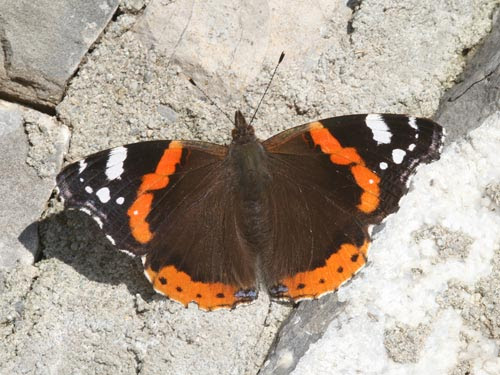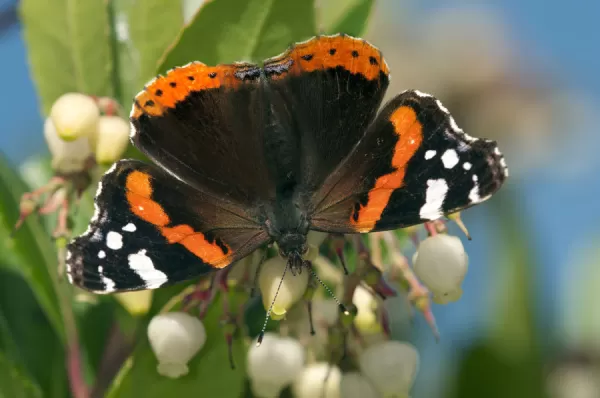Admiral butterfly (Vanessa atalanta) is one of the most beautiful and famous butterflies in the world. Its black and red color with white spots on the front wings makes it recognizable even among newcomers to the world of entomology.
This species belongs to the family sunfish (Nymphalidae) yes there is a migratory butterfly, who travels hundreds and even thousands of kilometers every year in search of a comfortable climate.
In this article, we will look at biological characteristics, behavior, habitat, reproduction process, threats and interesting facts about the admiral.

Scientific classification
🔬 Admiral butterfly classification:
✔ The Kingdom: Animals (Animalia)
✔ Type: Arthropods (Arthropoda)
✔ Class: Insects (Insecta)
✔ Row: Lepidoptera (Lepidoptera)
✔ Family: Solntseviki (Nymphalidae)
✔ Gender: Vanessa
✔ View: Vanessa atalanta
📌 Interesting!
The Admiral butterfly belongs to of the same lineage as monarchs, which also undertake large migrations.
Appearance and dimensions
💠 Main Features:
• Wingspan: 50–65 mm.
• Front wings: black with a red-orange stripe and white spots.
• Rear wings: brownish-black with a bright orange edge.
• Abdomen: dark, covered with fine hairs.
• Sexual dimorphism: Males and females are almost indistinguishable in appearance.
📌 Interesting!
Admiral's coloring performs camouflage role: in flight, bright colors scare away predators, and at rest, when the wings are folded, the butterfly looks like a dry leaf.
Habitat and distribution
🌍 Where does the admiral butterfly live?
• Europe, Asia, North Africa, North America.
* Prefers forest edges, meadows, gardens, parks, swamps.
• Often found near farms, fields, vineyards.
📌 Interesting!
This one of the few butterflies that can appear even in cities, where flowering areas are found.
Life cycle of the admiral butterfly
The life cycle of the admiral butterfly includes four stages:
1️⃣ Egg
• It is deposited on the leaves of fodder plants (most often on nettles).
• Has a greenish or pale yellow color.
• Development lasts 4–10 days.
2️⃣ Caterpillar
• Length: up to 4 cm.
• Color: dark, with white spots and spikes.
• Feeds on nettle, hop, and willow leaves.
• Development period: 2-3 weeks.
3️⃣ Pupa
• Attaches to leaves, stems or branches.
• Color: grayish or brown with golden hues.
• Duration of the stage: 8–15 days.
4️⃣ Imago (adult butterfly)
* Live up to 6 weeks in older generations and up to 9 months in wintering individuals.
* Powered by flower nectar, fruit juice, wood microflora.
📌 Interesting!
The caterpillar often builds itself leaf shelter, twisting them with cobwebs!

Flights and migrations
🦋 The Admiral butterfly is one of the best travelers among insects!
• Northern populations migrate in the fall to the south (to the Mediterranean, North Africa, India).
• In the spring they return, overcoming thousands of kilometers.
📌 Interesting!
Admirals often overcome The English Channel and even the Atlantic Ocean, appearing on the islands!
Behavior and lifestyle
🌞 Daily active lifestyle
• The flight is fast, powerful, the butterfly can stop in the air like a hummingbird.
• Likes to sit on sunny meadows and tree trunks.
🥀 Food
• Basic diet: flower nectar, fruit juice, occasionally aphid honeydew.
• In autumn, he likes overripe plums, apples, pears.
📌 Interesting!
Admirals can defend their flower territories, driving away other butterflies.
Natural enemies and threats
⚠ Main predators:
• Birds (tits, sparrows, woodpeckers).
• Spiders (caught in spider webs).
• Wasps and ants (attack the caterpillar).
⚠ Major threats to the species:
✔ Climate change (reduction of the activity period).
✔ Use of pesticides.
✔ Destruction of natural habitats.
📌 Interesting!
Despite threats, the admiral butterfly remains a numerous species in many regions of the world!

Interesting facts about the Admiral butterfly
🔹 Wintering butterflies
• Unlike most butterflies, the admiral can overwinter as an adult.
• In the warmth of winter, it is active even in January and February!
🔹 The caterpillar changes color depending on the temperature
• In warm weather it brown, in the cold – black.
🔹 Admiral butterflies love to land on people
• They can rest on shoulders, arms, headsbecause they are attracted to salt on the skin.
Conclusion
Admiral butterfly (Vanessa atalanta) is amazing traveler, which makes long-distance flights every year. Its bright colors, impressive flight speed and unique behavior make it one of the most interesting butterflies in the world.
💡 Protecting nature means protecting such wonderful creatures as the admiral!